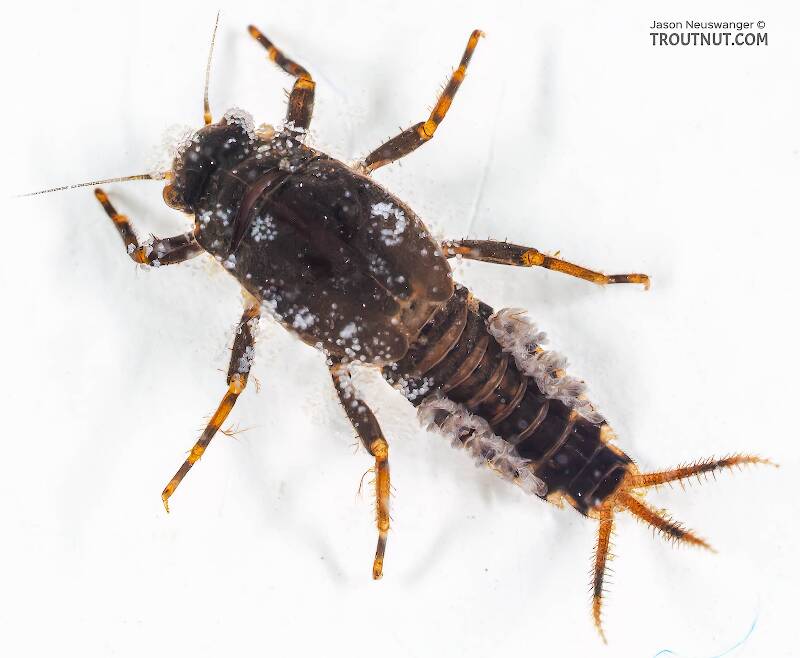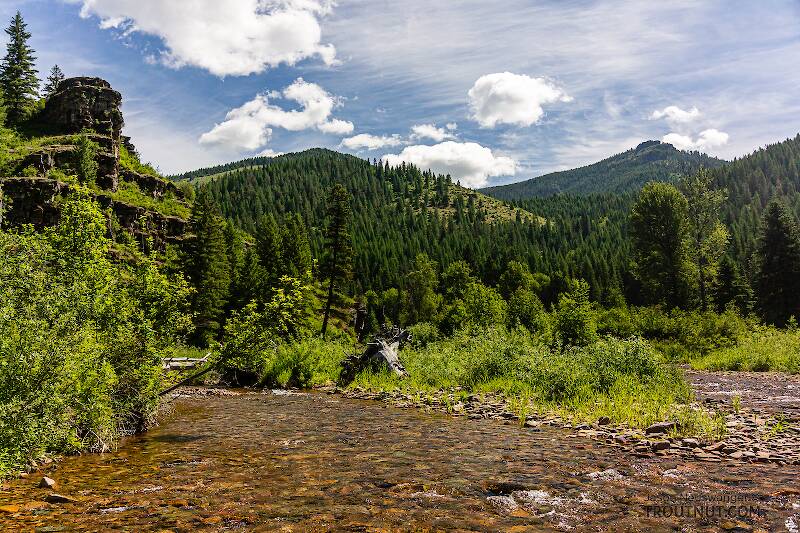
Blue-winged Olives
Baetis
Tiny Baetis mayflies are perhaps the most commonly encountered and imitated by anglers on all American trout streams due to their great abundance, widespread distribution, and trout-friendly emergence habits.


Mayfly Species Teloganopsis deficiens (Little black Quills)
Until recently, this species was known as Serratella deficiens.
Where & when
Most writers say this species emerges in June and July, but Caucci and Nastasi in Hatches II report that it is important in the Catskills in the late summer and fall. The others might be referring to hatches in the Midwest, where the species is also prolific, or there may be some confusion between species.In 13 records from GBIF, adults of this species have been collected during June (46%), July (23%), December (15%), February (8%), and August (8%).
In 19 records from GBIF, this species has been collected at elevations ranging from 299 to 2559 ft, with an average (median) of 1982 ft.
Species Range
Hatching behavior
The tiny duns take a while to break through the surface film, and then they linger on the surface before flying off. Despite their small size they can provide excellent fishing where they are abundant.The angling literature says they hatch in late morning, and anglers familiar with the hatch confirm this, but they also report afternoon and evening hatches.
Spinner behavior
These spinner falls are unimportant.Nymph biology
Current speed: Slow to medium
Substrate: They do especially well in weedy streams.
Physical description
Most physical descriptions on Troutnut are direct or slightly edited quotes from the original scientific sources describing or updating the species, although there may be errors in copying them to this website. Such descriptions aren't always definitive, because species often turn out to be more variable than the original describers observed. In some cases, only a single specimen was described! However, they are useful starting points.
Male Spinner
Wing length: 5 mm
A member of the serrata (now a synonym of Serratella serrata) group; distinguished fromE. sordida (now a synonym of Serratella serrata), in the male imago, by the deep blackish brown abdominal tergites, the prominent dark apical spot on the middle and hind femora, and the blackish apical portion of the penes. Head and thorax blackish brown. Eyes reddish brown, antennae brown. Vertex of head in female deep wine-red. Pronotum brown; mesothorax and metathorax brown, likewise the pleura, all with blackish markings. Sternum brown. Coxae brown; legs nearly white, the femora with a prominent dark brown spot apically, especially prominent on the middle and hind legs. Wings hyaline, veins pale; brown shading at base of wings. Abdominal tergites deep blackish brown; sternites paler. Tails pale, the joinings narrowly but distinctly purplish brown. Forceps pale; penes whitish basally, blackish apically (see fig. 156).
Nymph
Nymph blackish (rarely dull brown), usually with a pale median thoracic stripe dorsally. Head and thorax smooth; maxillary palp entirely wanting; no dorsal abdominal spines. Lateral extensions of the abdominal segments and postero-lateral spines only moderately developed; tips of the spines whitish. Gills present on segments 3-7. Each claw with 8-9 denticles. Tails yellowish brown; a wide dark median band crosses the two outer ones; at each joining, a circle of prominent spines. Femora dark brown, tibiae and tarsi yellowish with wide brown bands. Two pale spots laterally on each side of the pronotum.
Specimens of the Mayfly Species Teloganopsis deficiens
1 Nymph

Start a Discussion of Teloganopsis deficiens
References
- Arbona, Fred Jr. 1989. Mayflies, the Angler, and the Trout. Nick Lyons Books.
- Caucci, Al and Nastasi, Bob. 2004. Hatches II. The Lyons Press.
- Knopp, Malcolm and Robert Cormier. 1997. Mayflies: An Angler's Study of Trout Water Ephemeroptera . The Lyons Press.
- Leonard, Justin W. and Fannie A. Leonard. 1962. Mayflies of Michigan Trout Streams. Cranbrook Institute of Science.
- Needham, James G., Jay R. Traver, and Yin-Chi Hsu. 1935. The Biology of Mayflies. Comstock Publishing Company, Inc.
Mayfly Species Teloganopsis deficiens (Little black Quills)
Species Range
Common Names
Resources
- NatureServe
- Integrated Taxonomic Information System
- Global Biodiversity Information Facility
- Described by Morgan (1911)

